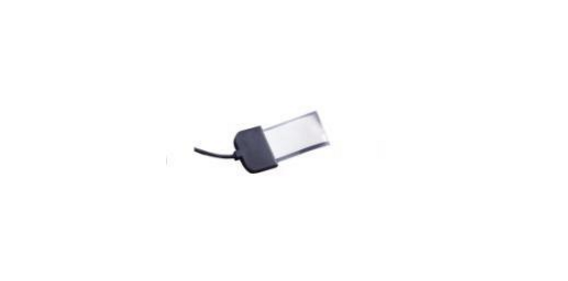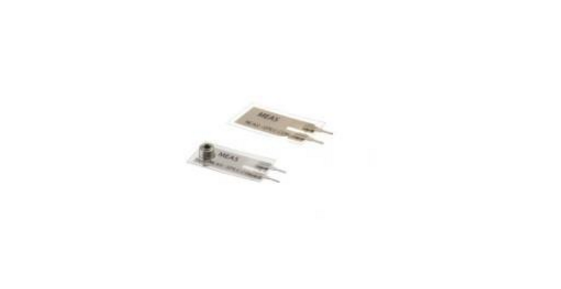The working principle and application of piezoelectric film sensor
Piezoelectric film has unique characteristics as a dynamic strain sensor, which is very suitable for life signal monitoring on human skin surface or implanted inside the human body. Some membrane elements are sensitive enough to detect the body's pulse across the outer casing. This article will focus on the typical applications of several piezoelectric films in the monitoring of vital signs.
working principleWhen you stretch or bend a piece of piezoelectric polyvinylidene fluoride PVDF polymer film (piezoelectric film), an electrical signal (charge or voltage) is generated between the upper and lower electrode surfaces of the film, and the deformation is the same as stretching or bending. Proportionate. Generally, piezoelectric materials are sensitive to pressure, but for piezoelectric films, when a small force is applied in the longitudinal direction, a large stress is generated in the lateral direction, and if the same force is applied to a large area of ​​the film, The stress will be much smaller. Therefore, the piezoelectric film is very sensitive to dynamic stress, and the sensitivity of the 28 μm thick PVDF is typically 10 to 15 mV/micro strain (percentage change in length).
The term 'dynamic stress' is used because the charge generated by the deformation is lost from the circuit connected to the film, so the piezoelectric film cannot detect static stress. When it is necessary to detect different levels of pre-stress, this becomes the advantage of the piezoelectric film. The film only senses the amount of change in stress, with a minimum response frequency of 0.1 Hz.
Introduction to Piezoelectric Thin Film SensorsThe piezoelectric film sensor has unique characteristics as a dynamic strain sensor, which is very suitable for life signal monitoring on human skin surface or implanted inside the human body. Some membrane elements are sensitive enough to detect the body's pulse across the outer casing. The work network will focus on the typical applications of several piezoelectric films in the monitoring of vital signs.
Piezoelectric film sensor worksWhen you stretch or bend a piece of piezoelectric polyvinylidene fluoride PVDF polymer film (piezoelectric film), an electrical signal (charge or voltage) is generated between the upper and lower electrode surfaces of the film, and the deformation is the same as stretching or bending. Proportionate. Generally, piezoelectric materials are sensitive to pressure, but for piezoelectric films, when a small force is applied in the longitudinal direction, a large stress is generated in the lateral direction, and if the same force is applied to a large area of ​​the film, The stress will be much smaller. Therefore, the piezoelectric film is very sensitive to dynamic stress, and the sensitivity of the 28 μm thick PVDF is typically 10 to 15 mV/micro strain (percentage change in length).
The term 'dynamic stress' is used because the charge generated by the deformation is lost from the circuit connected to the film, so the piezoelectric film cannot detect static stress. When it is necessary to detect different levels of pre-stress, this becomes the advantage of the piezoelectric film. The film only senses the amount of change in stress, with a minimum response frequency of 0.1 Hz.
Piezoelectric film sensor features
Piezoelectric films are thin, lightweight, very flexible and can be used passively, so they can be widely used in medical sensors, especially when it is necessary to detect subtle signals. Obviously, the characteristics of this material are particularly prominent in the case of limited power supply (in some structures, even a small amount of energy can be generated). And piezoelectric films are extremely durable and can withstand millions of bends and vibrations.
Piezoelectric film sensor applicationsContact sensor
Using the dynamic strain gauge properties of the piezoelectric film, the piezoelectric film can be easily attached directly to human skin (such as the inside of the wrist). Precision Electronics - The US Model MEAS Sensor Model 1001777 is a universal sensor with one side of the sensor coated with pressure sensitive adhesive. However, this adhesive is not biocompatible. In the short-term test, 3M9842 (polyurethane tape) can be fixed on the skin, and the piezoelectric film sensor is attached to the 3M tape.
Piezoelectric films are capable of detecting very small physical signals and can experience large amounts of activity because the piezoelectric response of PVDF films is linear over a relatively large dynamic range (approximately 14 orders of magnitude). In most cases, as long as the bandwidth of the target signal and noise can be clearly distinguished, small target signals can be collected through the filter.
Similar sensors have been used in sleep disorder studies to detect movement of the chest, legs, eye muscles and skin. In addition, the sensor can be used as an indicator of the anesthetic effect (neuromuscular conduction) by detecting the response of the muscle (such as the muscle between the thumb and the index finger) to the shock.
Accelerometer
The Minisense 100 is a standard product of precision electronics. It is designed with a cantilever beam. One end is clamped with a rigid PCB board and has a connecting pin and the other end is fitted with a mass. The mass causes the sensor to react consistently when subjected to vibration. The mass 'keep' and the film portion deforms, resulting in very high voltage sensitivity (approximately 1V/g). Other life sensor sensors are derived from this component, such as smart badges (built-in RF remote sensing devices) worn by workers or patients. The wearer's signal is collected periodically to determine its position and track its status. The sensor senses that the badge is set to sleep when it is removed; if the sensor senses movement of any part of the body, muscle tremors, or even pulse vibrations, it will wake up the badge.
auscultation
Many electronic stethoscopes use a piezoelectric film as a sensor element because of its durability, high sensitivity, and wide bandwidth. In this application, the sensor elements are typically packaged in a conventional metal auscultation head because the sensor needs to form a 'force' with the body. Once the dynamic pressure signal is converted into an electrical signal, it can be selectively filtered or amplified, played back as an audio signal, used a more complex calculation method to determine a specific condition, or transmitted to a remote base station for further analysis and storage.
Sensor group
A composite acoustic sensor can monitor multiple points simultaneously. DeepBreeze uses a sensor group with nearly 100 sensors to collect sound information about patient inhalation and exhalation. Use a vacuum cover to attach the sensor to the skin surface. The acquired signal is converted into an 'image' of the sound after processing, so that the airflow in the trachea and lungs can be imaged like a cartoon. Any foreign objects and abnormalities are visible in these images. This method is more reliable and safe than X-ray.
Bed monitoring
Both the piezoelectric film and the piezoelectric cable can be mounted on a mattress to detect the patient's heartbeat, breathing and body movements. The monitoring bed alarm system of Hoana Medical Inc. installed a set of sensors between the mattress and the sheet. When the patient sits or lies on the monitoring bed, the sensor can accurately collect the patient's vital signs information through the clothes and the sheets. The flexible switch is used to collect static signals. All the dynamic signals of the patient are collected by the piezoelectric film and converted into corresponding electrical signals, which are displayed on the display on the side of the bed. The patient's heart rate and respiratory rate are abnormal, or the patient can get an alarm in advance when the patient gets out of bed. It's all done by the sensor without having to be in direct contact with the patient.
Baby respiratory monitor
Infantrust has developed a complementary parenting product, Respisense, using PVDF's extremely stress-sensitive properties. Monitor the baby's heartbeat by placing the monitor in the position where the diaper is close to the baby's waist. The piezoelectric film in Respisense is in direct contact with the abdominal skin. If the baby is not detected during the set time, the vibrating buzzer will be activated, gently urging the baby to stimulate it to breathe. If the baby still does not respond for a period of time thereafter, the alarm will be activated.
Respiratory thermoelectric monitoring
PVDF is also quite sensitive to dynamic changes in temperature (typical values ​​for 28μm thick piezoelectric films are 8V/oC). British C-Lect Medical has developed a monitor to monitor breathing rate. A small piece of piezoelectric film element is fixed at the mouth and nose with a mask, and the temperature change of the inhaled and exhaled gases produces a strong electrical signal. Even if the inhaled oxygen/air is inhaled, the measurement results are still very accurate. The PIPPA monitor is battery powered and the LCD displays the number of breaths per minute. Lip-contact sensors made with piezoelectric films use the same principle to detect airflow through the mouth or nose. Compared with the thermistor, the piezoelectric film has high sensitivity, fast response, softness, and large detection area.
Piezoelectric film sensor product recommendation

US MEAS Piezo Film Sensor - SDT1-028K
SDT1-028K Piezoelectric Thin Film Sensor: The "S" in SDT means "shield". The SDT1 piezoelectric film sensor consists of a rectangular piezoelectric film element connected to a plastic case and an 18-inch long coaxial cable. The film element is screen printed with silver paste on top and bottom, and then folded in half to form a self-shielding work area. This product can be used in high EMI environments.

US MEAS DT Piezo Film Sensor - DT Series
The DT series of piezoelectric film sensor elements are rectangular piezoelectric film elements of silver ink screen electrodes, which are available in many different sizes and thicknesses. The strain per micron of the DT series of thin-film components produces a voltage signal of more than 10 millivolts, which is about 60 dB higher than the voltage output of the foil metal strain gauge. The capacitance is proportional to the area of ​​the component and inversely proportional to the thickness of the component.

US MEAS Piezo Film Sensor Vibration Sensor - LDT Series
LDT0 is a flexible component that screens a silver paste electrode on a 28μm PVDF piezoelectric film. The film is laminated on a 0.125mm polyester substrate and has two crimp terminals. Since the piezoelectric film deviates from the central axis, the bending can generate a high strain in the film and thus have a high voltage output.
Hf Drivers - Ferrite,Titanium Tweeter Driver,Titanium Compression Drivers,Line Array Speaker Driver
NINGBO BOILINGSOUND ELECTRONICS CO.,LTD , https://www.tweeterspeaker.com
